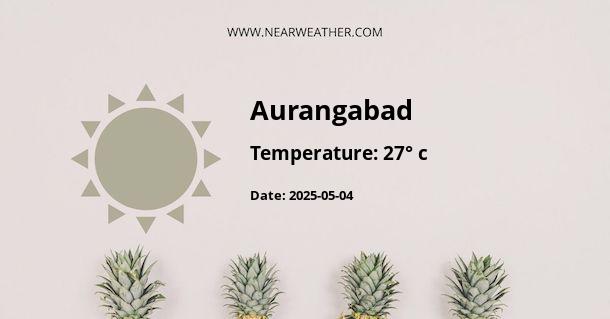Aurangabad Division, IN: Climate and Weather Overview
Aurangabad Division is located in the state of Maharashtra, India. It is known for its rich historical and cultural heritage, including the famous Ellora and Ajanta Caves. The division comprises five districts: Aurangabad, Jalna, Beed, Osmanabad, and Nanded. Each district has its own unique climate and weather patterns throughout the year.
Aurangabad District
Aurangabad district experiences a hot semi-arid climate. Summers are extremely hot and dry, with temperatures often soaring above 40°C (104°F). The months of April and May are the hottest, with average maximum temperatures reaching around 42°C (108°F). The heat is accompanied by low humidity, making it feel even hotter.
Monsoon season in Aurangabad district starts in June and lasts until September. The region receives moderate to heavy rainfall during this time, which helps in providing relief from the scorching heat. The average annual rainfall in Aurangabad is around 700-800 mm.
Winters in Aurangabad are mild and pleasant, with temperatures ranging from 10°C to 25°C (50°F to 77°F). The months of December and January are the coldest, with average minimum temperatures dropping to around 10°C (50°F). However, cold waves from northern regions can occasionally result in temperatures dropping even lower.
Jalna District
Jalna district has a similar climate to Aurangabad district, characterized by hot summers and mild winters. The maximum temperature during summers can reach up to 42°C (108°F) in the months of April and May. The region receives moderate rainfall during the monsoon season, with an average annual rainfall of around 700-800 mm.
Winters in Jalna are relatively cooler than summers, with temperatures ranging from 8°C to 25°C (46°F to 77°F). The coldest months are December and January, with average minimum temperatures dropping to around 8°C (46°F). However, extreme cold conditions are rare in this region.
Beed District
Beed district also experiences a hot semi-arid climate, similar to Aurangabad and Jalna districts. Summers are extremely hot, with maximum temperatures often surpassing 40°C (104°F). The months of April and May are the hottest, with average maximum temperatures reaching around 42°C (108°F).
The monsoon season in Beed starts in June and lasts until September. The district receives moderate to heavy rainfall during this time, with an average annual rainfall of around 700-800 mm. The rainfall provides relief from the scorching heat and helps in agricultural activities.
Winters in Beed are relatively mild, with temperatures ranging from 10°C to 25°C (50°F to 77°F). The coldest months are December and January, with average minimum temperatures dropping to around 10°C (50°F). However, severe cold conditions are rare in this region.
Osmanabad District
Osmanabad district has a hot semi-arid climate, similar to other districts in the division. Summers are extremely hot and dry, with temperatures often exceeding 40°C (104°F). The months of April and May are the hottest, with average maximum temperatures reaching around 42°C (108°F).
During the monsoon season, Osmanabad receives moderate to heavy rainfall, which helps in replenishing the water resources in the region. The average annual rainfall in Osmanabad is around 700-800 mm. Monsoon season starts in June and lasts until September.
Winters in Osmanabad are mild and pleasant, with temperatures ranging from 10°C to 25°C (50°F to 77°F). The coldest months are December and January, with average minimum temperatures dropping to around 10°C (50°F). However, extreme cold conditions are rare in this region.
Nanded District
Nanded district also experiences a hot semi-arid climate, similar to other districts in the division. Summers are extremely hot, with maximum temperatures often exceeding 40°C (104°F). The months of April and May are the hottest, with average maximum temperatures reaching around 42°C (108°F).
During the monsoon season, Nanded receives moderate to heavy rainfall. The average annual rainfall in Nanded is around 700-800 mm. Monsoon season starts in June and lasts until September. The rainfall helps in replenishing the water resources and supports agricultural activities in the region.
Winters in Nanded are relatively mild, with temperatures ranging from 10°C to 25°C (50°F to 77°F). The coldest months are December and January, with average minimum temperatures dropping to around 10°C (50°F). However, extreme cold conditions are rare in this region.
Conclusion
Aurangabad Division in Maharashtra, India, experiences a hot semi-arid climate with extremely hot and dry summers. The monsoon season brings relief with moderate to heavy rainfall, supporting agriculture in the region. Winters are mild and pleasant, with temperatures dropping to around 10°C (50°F). Overall, the climate in Aurangabad Division is characterized by hot summers, moderate rainfall, and mild winters.
A - Aurangabad's Latitude is 19.884670 & Longitude is 75.339859.
A - Weather in Aurangabad is 23° today.
A - Climate Conditions in Aurangabad shows overcast clouds today.
A - Humidity in Aurangabad is 87% today.
A - Wind speed in Aurangabad is 10.15 km/h, flowing at 291° wind direction. today.
